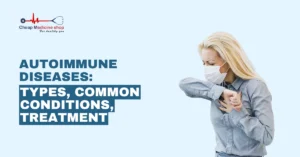Leukemia is a complex set of Blood Cancers that impairs the body’s capacity to fight infections and generate healthy blood cells. While the diagnosis might be stressful, developments in medical science have altered the therapeutic scenario by extending the supply of effective medications.
From traditional chemotherapy to cutting-edge, targeted therapies and immunotherapies, Leukemia treatment is now more precise and personalized than ever before. These Leukemia medications attempt to prevent Cancer by targeting particular genetic alterations or stimulating the immune system to remove cancerous cells.
This article focuses on the three main types of medications used to treat various forms of Leukemia, how they work, and the hope they provide to patients and families dealing with this life-threatening illness.
3 Best Leukemia Medications
Whether it’s a child with Acute Lymphoblastic Leukemia or an adult with Chronic Myeloid Leukemia, the proper medication can be the difference between long-term remission and recurrence. A one-size-fits-all medical treatment for Leukemia does not exist. Instead, medicinal plans are highly personalized, including chemotherapy, targeted therapies, and immunotherapy.
Let’s look at these medicines in detail.
Save up to 90% on your medicine bills

Abraxane 100 Mg Injection

Alphalan 5 Mg Tablets

Adriamycin 50 Mg Injection

Abirapro 250 Mg Tablet
1. Chemotherapy
Chemotherapy is an integral part of Leukemia Treatment. These medicines target cells that divide fast, including Leukemia cells. They can be delivered orally or intravenously, and the specific medications, doses, and combinations vary according to the stages and types of Leukemia, often including:
- Acute Myeloid Leukemia medication: The usual starting dose of Acute Myeloid Leukemia (ALL) is termed 7+3, which includes a 7-day continuous infusion of Cytarabine and a 3-day course of an Anthracycline (Daunorubicin or Idarubicin). Azacitidine, Decitabine, Mitoxantrone, and Midostaurin are also used to treat FLT3-mutated ALL.
- Acute Lymphoblastic Leukemia medication: Acute Lymphoblastic Leukemia (ALL) is treated with multi-phase chemotherapy (induction, consolidation, and maintenance) that lasts roughly two years. Common medications include Vincristine, corticosteroids (Dexamethasone or Prednisone), anthracyclines, Cyclophosphamide, L-asparaginase, Methotrexate, and Cytarabine.
- Chronic Lymphocytic Leukemia medications: Fludarabine, Cyclophosphamide, Bendamustine, and Chlorambucil are common chemotherapy medications used to treat Chronic Lymphocytic Leukemia (CLL). They are frequently coupled with monoclonal antibodies such as Rituximab to enhance their effectiveness.
- Chronic Myeloid Leukemia (CML): Traditional chemotherapy is rarely utilized for CML; targeted therapy is recommended.
2. Targeted therapy
Targeted therapy for Leukemia involves medications that target specific genetic abnormalities or molecular pathways that cause Cancer cells to grow. This provides a more precise and typically less toxic alternative to standard chemotherapy. These medicines are intended to disrupt Cancer’s survival systems while causing little damage to healthy cells.
- Tyrosine Kinase Inhibitors (TKIs), such as Imatinib, Dasatinib, and Nilotinib, have transformed the treatment of CML by inhibiting the function of the BCR-ABL fusion protein.
- In CLL, medications such as Ibrutinib and Acalabrutinib target Bruton’s Tyrosine Kinase (BTK), interrupting B-cell receptor signaling, whereas Venetoclax inhibits BCL-2, promoting Cancer cell death.
3. Immunotherapy

Immunotherapy uses the body’s immune system to fight Cancer. The following types of immunotherapy are used in Leukemia:
- Monoclonal antibodies: These laboratory-created antibodies target particular proteins in Leukemia cells, directing the immune system to destroy them. Rituximab, Ofatumumab, and Obinutuzumab are anti-CD20 antibodies used in CLL, Blinatumomab is a BiTE antibody targeting CD19 and CD3 in Acute Myeloid Leukemia, and Inotuzumab Ozogamicin is an antibody-medication combination targeting CD22 in ALL.
- CAR T-cell therapy (Chimeric Antigen Receptor T-cell therapy): This latest treatment includes changing a patient’s own T-cells (types of immune cells) to detect and target Leukemia cells. It treats relapsed or refractory Leukemias, namely ALL and certain Lymphomas. Examples are Tisagenlecleucel and Brexucabtagene Autoleucel.
- Checkpoint inhibitors: These medications inhibit proteins that allow Cancer cells to pass through the immune system. They are being studied in various Leukemias, although they are not yet considered a conventional treatment for most of them.
Leukemia medication side effects
While Leukemia medicines are typically lifesaving, they can lead to several side effects that differ depending on the medication and the individual’s reaction.
- Chemotherapy can cause fatigue, nausea, vomiting, hair loss, mouth sores, and a compromised immune system due to low blood counts (Myelosuppression).
- Targeted therapy, such as TKIs or BCL-2 inhibitors, might induce diarrhea, muscular cramps, liver enzyme abnormalities, heart rhythm problems, and increased bleeding risk.
- Immunotherapies, including monoclonal antibodies and CAR T-cell treatment, can cause infusion reactions, cytokine release syndrome (fever, Low Blood Pressure, disorientation), and neurotoxicity. As per a review published by The Clinical Journal of Oncology Nursing (CJON) in 2007, cytokine release syndrome have been found to be associated with many monoclonal antibodies.
- Some medications, such as corticosteroids taken in combination therapies, can cause weight gain, mood swings, and Diabetes.
Conclusion
Leukemia medications have advanced significantly, providing new hope to patients and families impacted by this devastating Blood Cancer. Today, doctors have many treatment options, including chemotherapy, targeted therapy, and immunotherapy.
Each type of medicine works differently—some kill Cancer cells directly, while others aid the immune system in fighting the disease or block signals that Cancer cells require to grow. While some treatments may have side effects, doctors strictly monitor patients and provide supportive care to assist manage them.
The choice of medicine is based on the type of Leukemia, the patient’s overall health, and how the Cancer responds to treatment. Ongoing research continues to improve these treatments, bringing us closer to a future where Leukemia can be cured or controlled with fewer side effects and a better quality of life.
Frequently Asked Questions
Which Leukemia is hardest to treat?
Acute Myeloid Leukemia (AML), especially in older adults or those with high-risk genetic mutations, is often considered the hardest to treat due to its aggressive nature, resistance to therapy, and higher risk of relapse after treatment.
Does Insurance cover leukemia medications in the U.S.?
Yes, most Leukemia medications are covered by health insurance companies in the U.S., including Medicare and private plans. Still, coverage levels, co-pays, and prior authorization requirements vary depending on the drug, plan, and provider network.
Can I take over-the-counter medications or supplements while on Leukemia treatment?
No. It is not advised. You should always consult your doctor before taking any over-the-counter medicines or supplements during leukemia treatment, as some can interfere with your prescribed medicines, decrease effectiveness, or increase the risk of side effects and complications.
How long will I need to take Leukemia medication?
The duration of Leukemia medicine depends on the type of Leukemia, treatment response, and medications used. Some treatments last months, while others, like targeted therapies for chronic Leukemias, may be taken for years or even lifelong.
What was the first medicine for Leukemia?
The first medicine used to treat Leukemia was Aminopterin, a folic acid antagonist, introduced in the 1940s. It marked the beginning of chemotherapy for Leukemia and showed temporary remission in children with Acute Lymphoblastic Leukemia (ALL).
Cheap Medicine Shop only refers to credible, authoritative sources for our content. If you’re curious about how we ensure the integrity of our content, we encourage you to read our Content Information Policy.














